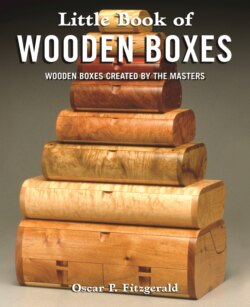Читать книгу Little Book of Wooden Boxes - Oscar Penn Fitzgerald - Страница 14
Boxes in the Kitchen
ОглавлениеWith the introduction of tea drinking into England by Catherine of Braganza, the Portuguese wife of Charles II in the seventeenth century, tea caddies proliferated. (A “caddy” was originally a measure of weight, but it soon became associated with the container for tea.) Usually with two compartments, these little boxes held both black and green tea.
Since colonial times, salt was used primarily as a preservative, but also for seasoning. Saltboxes with slanted lids typically hung on the wall near the hearth to keep the salt dry. Most were wood and, at least in Pennsylvania, were usually painted with tulips, floral decorations, or geometric motifs.
Before the days of glass jars and tin cans, the pantry was filled with numerous round or oval boxes up to two feet in diameter mostly purchased from local woodworkers. Rectangular ones, often on a stand, held bread dough. Large ones held butter, cheese, and herbs. Smaller ones contained sugar and meal. The smallest were for spices.
Mid-nineteenth century yellow pine wall box from Virginia’s Shenandoah Valley constructed with pegs joining the sides and the bottom in the German tradition. These boxes were usually hung by the fire to keep the salt that was often stored in them dry.
The Shakers made the best ones. They steam-bent ash or maple strips around molds, secured the strips with copper rivets, added pine bottoms and tops, and then painted or varnished the entire assembly. As with wooden desk boxes, the wooden storage container gradually lost out to the tin boxes that proliferated after 1800.
